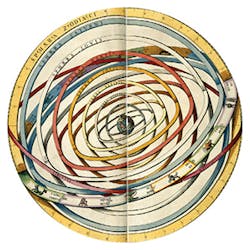SINCE THE INVENTION of the telescope in 1608, mapping the cosmos has captivated many of our imaginations. Beautifully complex maps from that era document the heavens in elaborate celestial charts. One of the most celebrated is the Atlas Coelestis, a 1660 collection of lavish engravings by Andreas Cellarius that illustrate the planetary orbits, planispheres, lunar phases, and constellations.
It’s apparent from these intricate depictions that the telescope opened mankind’s eyes to the universe. It offered a vantage point from which we came to understand that the Earth was not the center of the universe.
Whereas the telescope enabled mankind to observe the cosmos—to gaze at the craters of the moon, asteroids, and other planets—today’s technology offers us the inverse. Satellites, lidar, lasers, geographic information systems, sophisticated sensors, and digital communications platforms offer us a view of the earth from space. This omniscient perspective provides unprecedented insight that helps us understand global systems, facilitates the responsible management of water resources, and provides opportunities for a more holistic approach to global environmental efforts.
As an example, today’s technology allows NASA to actively monitor water on Earth by collecting data on soil moisture, snowpack, groundwater, atmospheric conditions, polar ice sheets, and global water cycles from space, which supports improved water management practices worldwide. In fact, a 2015 map of groundwater storage trends for the Earth’s 37 largest aquifers using GRACE data revealed that 21 aquifers have exceeded sustainability tipping points and are being depleted. 13 of these are considered significantly distressed, threatening regional water security and resilience. And now, armed with actionable intelligence, international organizations have an opportunity to make critical changes to groundwater management practices.
We highlight the technology facilitating global water management in this issue of Water Efficiency magazine, making particular note of international efforts to reduce non-revenue water, protect water resources, and provide communities around the world with access to clean water. Technology is the catalyst for many of these initiatives. And we’re thrilled to share with you some of the innovations taking place in water treatment, distribution, and management today.
In “Conserving Water and Preserving Life” we examine the water challenges faced by inhabitants of Cape Town, South Africa, where severe drought and over-burdened infrastructure has resulted in catastrophic deficits and water losses of approximately 36.8 %. This story explores a variety of ways to prevent water loss, such as system mapping, leak detection, and performing water audits, while also highlighting the exemplary practices and systems that experience minimal loss.
In “Smart Water for Smart Cities” we look at the way smart cities around the world use AMI data analytics to track water usage, find patterns, and manage resources. Information communication technology platforms facilitate this process by integrating data streams to produce actionable intelligence to inform utilities, provide them with valuable perspective, and help them map out effective strategies.
We address potential solutions to global water scarcity by outlining exciting new materials research in “Self-Healing Membranes.” Pore-filled membranes that incorporate hydrogels can restore themselves after being damaged or otherwise fouled, offering myriad opportunities for global water resource management.
Perspective often grants us the vantage point necessary to observe things with clarity. Today’s technology offers water professionals more actionable data insight than ever before. And by integrating this information, utilities are able to gain the big-picture perspective necessary to maximize asset reliability, meet regulatory requirements, operate our systems more efficiently, and conserve global resources. How does your organization use big-picture perspective to inform its decision-making?
